A miter saw is a tool that enables you to make cuts at varied angles. You can use miter saws to make quick cuts for picture frames, crown molding, window or door frames, and much more. But how to choose a Miter Saw?
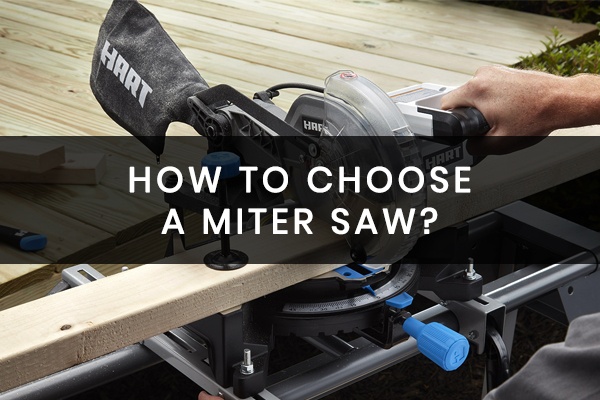
It is a valuable tool for beginners that help you make clean cuts precisely. The tool enables you to make angled cuts between 45 and 90 degrees. It is a valuable tool that allows DIYers for woodworking projects. A miter saw is a must for a fully operational workshop.
Are you looking for an ideal miter saw that enables you to make precision cuts? The following miter saw buying guide would help you choose the right miter saw based on your requirements.
Choose a Miter Saw by Type
Primarily, there are three kinds of miter saws. You can choose from among them based on the features and purpose that they fulfill for you.
Compound Miter Saw
Compound miter saw comes with added features that make it more versatile. It has blades that pivot right and left for making angled cuts and incline in a single direction for bevel cuts. A miter cut is angled through wood’s horizontal plane, while a beveled cut is angled through the vertical plane. A bevel cuts from top to bottom while not from side to side.
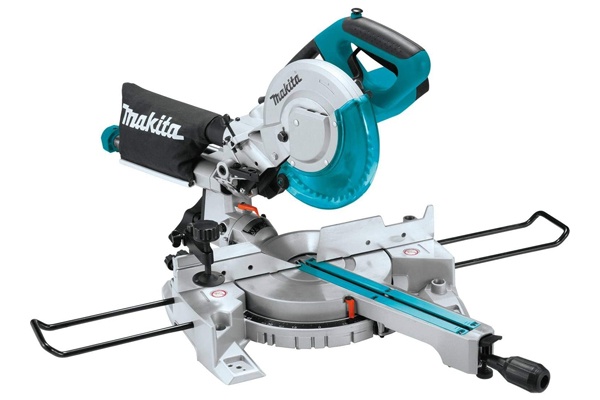
A compound miter saw is versatile in terms of the number of tasks it can complete. However, a basic miter saw is capable of making only basic cuts. You can manipulate the saw on both its axes at once to get miter cuts. You can use compound miter saws for making picture frames, angled cuts in two planes, and crown molding.
Another similar category is the dual-bevel miter saw in which blade angles can adjust to both left and right directions. The Makita LS1221 Miter Saw has a large cutting capacity that offers precise cutting. The tool has a robust motor and a pivoting fence that support larger material.
Dual Compound Miter Saws
A dual compound miter saw turns in both directions, left and right. The feature enables the tool to create bevels at any angle without flipping the workpiece. You need to rotate only the saw head while making a bevel cut at the opposite angle. You can make all angle cuts without repositioning the workpiece.
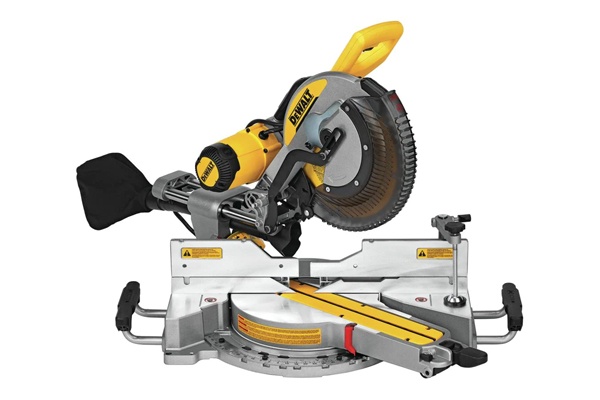
The tool makes repetitive cuts faster on longer workpieces. It improves efficiency and workflow for contractors or hobbyists who perform heavy-duty jobs.
Sliding Compound Miter Saws
The tool moves the saw head on a sliding rail backward and forwards as a radial arm saw. Sliding compound miter saw allows locking of rails for pull-down or straight cuts. The sliding feature allows making increases the length capacity it offers.
Sliding miter saws make miter cuts and crosscuts as they are heavier because of the additional components. You do not require a sliding feature if you do basic miter saw work. If you are a DIYer who cuts 2*4s, regular trim molding, and hardwood flooring, you do not require a sliding compound miter saw.
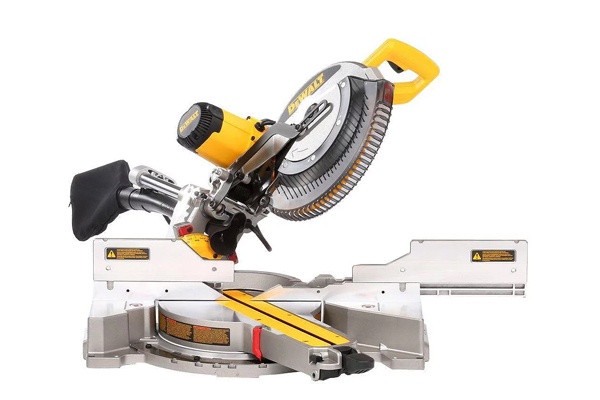
However, the tool is helpful for projects that require higher crosscutting capacities, cabinets, woodworking, and more oversized baseboard. For example, Bosch GCM12SD Miter Saw powerful motor offers increased alignment, broader cuts, and smooth glide. It is a versatile tool that makes accurate and quick cuts in many materials. The 12-inch blades and a lower guard provide clear cut-line visibility.
Corded or Cordless Miter Saw
A cordless miter saw is lightweight with a smaller footprint having cheaper blades. You can move a cordless miter saw from one job site to another. But the problem is that the cordless miter saw has the lesser horizontal and vertical cut capacity. It has a higher blade RPM.
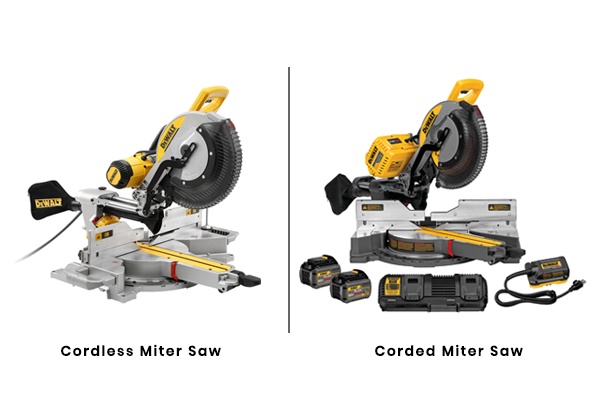
You might have to buy larger batteries for working with a cordless miter saw. These are particularly useful for medium-duty works. A corded miter saw does not require batteries as it exhibits slower blade speed. It is a stiffer saw that offers a higher cutting capacity. However, a corded saw is heavier than needs an extension cord and heavier to carry.
Most miter saws are corded with motors of 10-, 12- or 15-amp capacity. They are used to make wider crosscuts or use hardwoods.
What are the Features to Look for in a Miter Saw?
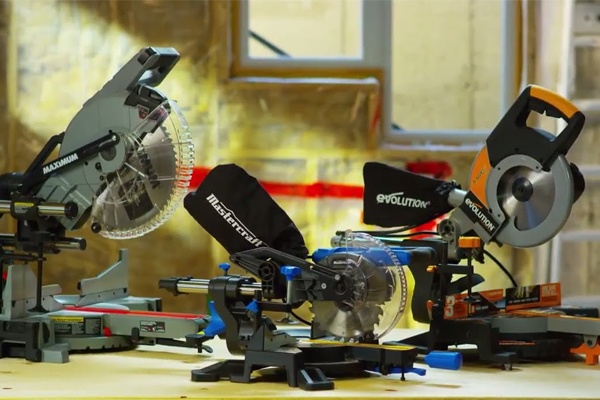
Noticeable the features that you should look in a miter saw while purchasing.
- Higher Amps– Amps measure the saw motor’s power. A higher amp implies the tool’s more cutting efficiency.
- Blade size –The blade determines the height or depth of cut. A good quality blade is determined by teeth number, hook angle, and kerf. A standard miter saw comes with 8,10, or 12-inch blades. There are blades for cutting wood, mild steel, and aluminum.
Tooth count ranges from 24-100 teeth per inch. A higher number of teeth and larger diameter will give a more extended and more refined cut. Kerf thickness signifies the amount of material that the blade removes while cutting.
The hook angle denotes the level of aggressiveness with which the blade will pull the material in. A low or negative hook angle can cause a little board movement.
- Positive Stops –Positive stops are factory set points that make precise cuts quickly on specific angles. More positive stops reduce the time required for setting up cuts. Some saws have thumb-activated stops for making adjustments rapidly.
- Depth Stops – Depth stops enable you to adjust the blade’s height. It controls how deeply the tool cuts into the material.
- Blade Guards – It clears the stock from the guard to give you a better view of the cutting line. The guard lowers to cover the blade on raising the saw.
- Electric Brakes –Electric brakes reverse electricity flow in the saw motor on releasing the trigger. The blade’s momentum can stop quickly by reversing the current. Electric brakes can stop the working blade within seconds that is much quicker than a blade without the feature.
- Dustbags stand directly to the saw to collect sawdust a little away from the workpiece while cutting. It enables you to work in appropriate hygienic conditions without dust all around. A dust bag ensures that you do not inhale the hazardous and unpleasant sawdust particles harmful to the lungs.
- Table extension connects to the saw’s sides and supports longer stock for an accurate cut.
- Laser guides –Laser guides or guide lights cast a shadow or beam on the workpiece to guide you accurately through the cuts.
- Displays –Digital displays in a miter saw provide miter setting information and bevel that is easy to read.
- Shaft locks –A power tool like a sliding compound miter saw includes a table. A shaft is present on the table with an axis. A support housing is movable axially along the shaft. A locking mechanism might have a handle placed on the shaft that is rotatable against the table.
Additional Consideration for Choosing the Miter Saw
Apart from the above features, additional considerations for selecting a miter saw are listed below. If you use a miter saw in a shop, you can mount it to a worktable.
- If you require transporting the saw to different worksites, you should use lighter models for greater portability.
- The blade is the saw’s crucial part. While purchasing, make sure the blade is well-suited with your miter saw and type of work.
- Ensure having a suitable cord when you use an extension cord with a miter saw.
- A stand is a crucial accessory as it holds the saw securely and limits vibration.
- Some miter saws have material stops that prevent you from marking multiple boards for the same cut. Instead, you only have to set the stop and cut.
Final Thoughts
The above guide includes all the necessary information that you must know for making a purchase. I have prepared the guide by doing thorough research on miter saws. I hope the guide will enable you to choose the appropriate miter saw based on your requirements.

Leave a Reply